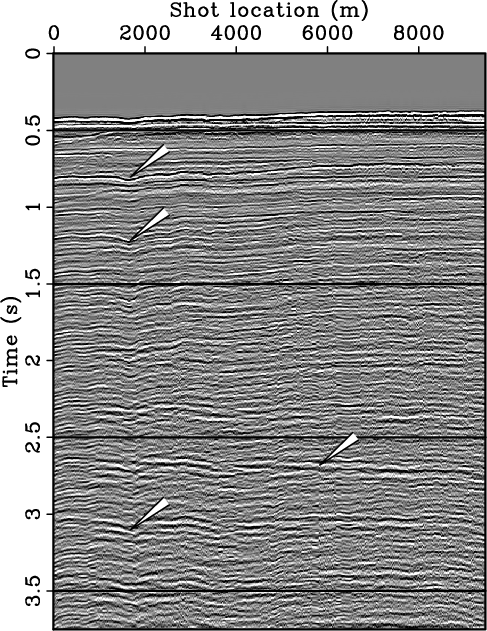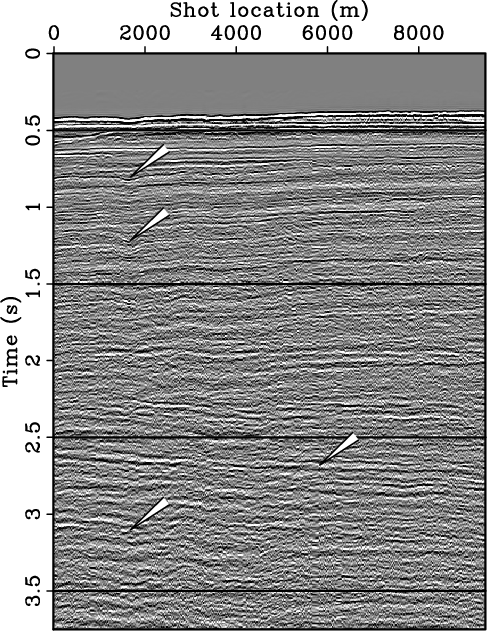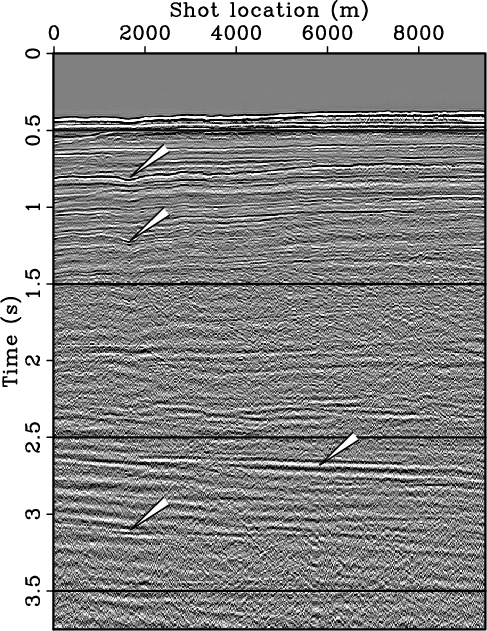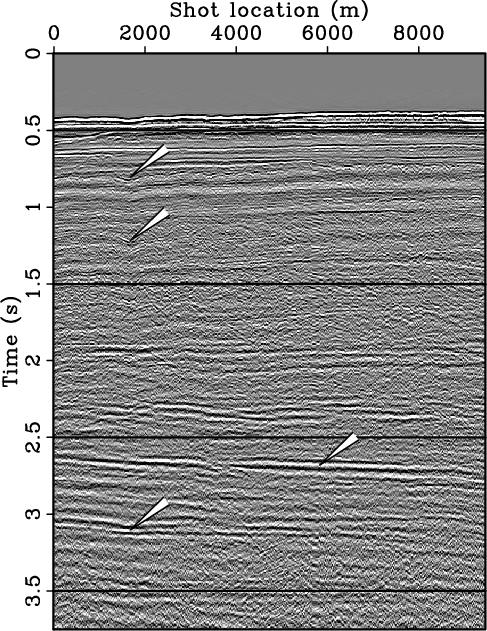|
|
|
|
Adaptive curvelet-domain primary-multiple separation |
Figure 2(a) contains the common-offset section (at
offset
![]() ) that we selected from a North Sea field
dataset. Estimated primaries according to conventional SRME are
plotted in Figure 2(b). Results where
) that we selected from a North Sea field
dataset. Estimated primaries according to conventional SRME are
plotted in Figure 2(b). Results where ![]() -matched
filtering in the shot domain (Verschuur and Berkhout, 1997) is replaced by
Bayesian thresholding (Saab et al., 2007) in the offset domain, are
presented for a single offset in Figure 2(c), without
scaling, and in Figure 2(d) with scaling. The scaled
result is calculated for
-matched
filtering in the shot domain (Verschuur and Berkhout, 1997) is replaced by
Bayesian thresholding (Saab et al., 2007) in the offset domain, are
presented for a single offset in Figure 2(c), without
scaling, and in Figure 2(d) with scaling. The scaled
result is calculated for
![]() . Juxtaposing the standard SRME
and the curvelet-based results shows a removal of high-frequency
clutter, which is in agreement with earlier findings reported in the
literature. Moreover, primaries in the deeper part of the section
(e.g. near the lower-two arrows in each plot) are much better
preserved, compared to the standard-SRME result. Removal of the strong
residual multiples in the shallow part, e.g. the first- and
second-order water bottom multiples indicated by the arrows around
. Juxtaposing the standard SRME
and the curvelet-based results shows a removal of high-frequency
clutter, which is in agreement with earlier findings reported in the
literature. Moreover, primaries in the deeper part of the section
(e.g. near the lower-two arrows in each plot) are much better
preserved, compared to the standard-SRME result. Removal of the strong
residual multiples in the shallow part, e.g. the first- and
second-order water bottom multiples indicated by the arrows around
![]() and
and
![]() , is particularly exciting. Due to the
unbalanced amplitudes of the predicted multiples, both standard SRME
and non-adaptive Bayesian thresholding are not able to eliminate these
events. Our adaptive method, however, successfully removes these
events by virtue of the curvelet-domain scaling. Compared to
non-adaptive thresholding, residual multiples are better suppressed,
while our adaptive scheme also leads to at least similar, but often
even better, overall continuity and amplitude preservation of the
estimated primaries. For example, improvements are visible in the
lower-left corner of the sections (between offsets
, is particularly exciting. Due to the
unbalanced amplitudes of the predicted multiples, both standard SRME
and non-adaptive Bayesian thresholding are not able to eliminate these
events. Our adaptive method, however, successfully removes these
events by virtue of the curvelet-domain scaling. Compared to
non-adaptive thresholding, residual multiples are better suppressed,
while our adaptive scheme also leads to at least similar, but often
even better, overall continuity and amplitude preservation of the
estimated primaries. For example, improvements are visible in the
lower-left corner of the sections (between offsets
![]() and times
and times
![]() , where
low-frequency multiple residuals are better suppressed after
curvelet-domain matched filtering
( cf. Figure 2(c) and 2(d)),
without deterioration of the primary energy. Finally, observe the
improved recovery of primary energy at the lower arrow in
Figure2(d), compared to the primary in
Figure 2(c).
, where
low-frequency multiple residuals are better suppressed after
curvelet-domain matched filtering
( cf. Figure 2(c) and 2(d)),
without deterioration of the primary energy. Finally, observe the
improved recovery of primary energy at the lower arrow in
Figure2(d), compared to the primary in
Figure 2(c).




|
|---|
|
Figure2-a,Figure2-b,Figure2-c,Figure2-d
Figure 2. Adaptive curvelet-domain primary-multiple separation on real data. (a) Near-offset ( |
|
|
|
|
|
|
Adaptive curvelet-domain primary-multiple separation |